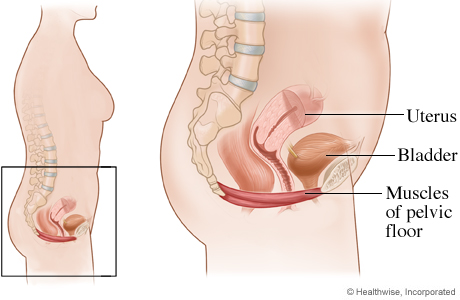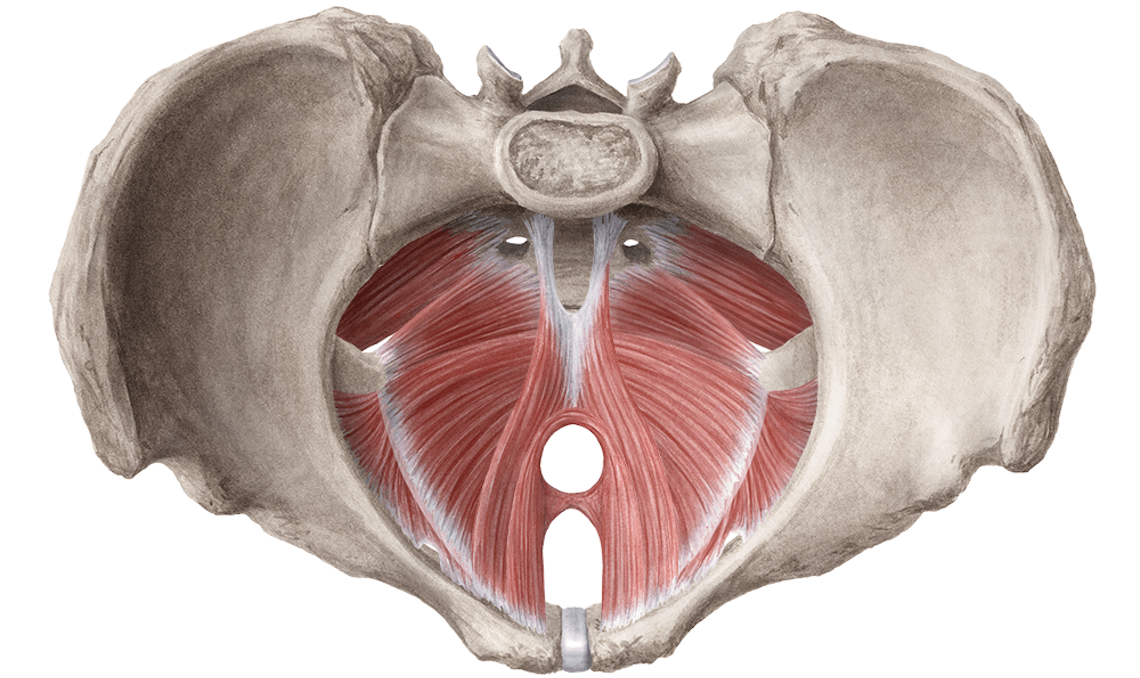Hello! I’m Jenny Telfer-Crum and I am a Women’s Pelvic Health Physiotherapist (aka Pelvic Physio).
This means I have regular Physiotherapy training (ie looking at pain and movement patterns through the neck, shoulders, back, hips, knees etc), but have also taken extra courses to be able to assess and treat the Pelvic Floor muscles.
My goal is to educate and empower women so that they can be comfortable and confident regarding their pelvic (and general!) health.
There is a lot of misinformation about bladder leaking, pelvic pain and discomfort out there, so in this blog I’m going to talk about the Pelvic Floor muscles, signs that something may not be working well for you, and how Pelvic Health Physiotherapy works.
What are the Pelvic Floor muscles?
The pelvic floor muscles are at the bottom of the pelvis, between the pubic bone at the front, the tailbone at the back, and the sit bones side to side.
They go around the urethra (where we pee), the vagina in women and the rectum (where we poop).
These muscles also interact with muscles and tissues in the abdomen, back, and hips (ie glutes and hip flexors).
Just like any muscle in the body, we want the Pelvic Floor muscles to be strong, flexible and coordinated in order to function at their best.
Common Myths about the Pelvic Floor:
- Bladder leaking/dribbling is normal after having a baby or as I get older
- FALSE! This is something that is “common, but not normal”. Pelvic Health Physiotherapy can help to address this, without surgery.
- Pain with sex is normal
- FALSE! Pain with sex can be due to tight pelvic floor muscles/related tissues and hypersensitivity of the nerves in the pelvis. These can be addressed through Pelvic Health Physiotherapy.
- My pelvic problems are not related to my back pain
- FALSE! All of the muscles in the body work together. If you have wrist pain, Physiotherapists look at your hand, wrist, elbow, even up into the neck! If you have back, hip, abdominal or even leg pain the pelvic floor muscles and structures can be contributing and/or reacting to the pain and muscle patterns you are using. It’s important not to overlook this piece of the puzzle.
When should I see a Pelvic Floor Physio?
The Pelvic Floor muscles work with the nervous system, abdominal pressure system and connective tissue system to support our pelvic organs (ie bladder, uterus and bowels).
That means that training these muscles to contract and relax appropriately can help with problems such as:
- bladder urgency and/or leaking (urinary incontinence)
- stress incontinence – leaking with laughing, coughing, sneezing, laughing, jumping, running
- urge incontinence – getting the sudden urge to pee then leaking before you get to the bathroom.
- bowel urgency or leaking (bowel incontinence)
- pelvic organ prolapse (heaviness or falling out sensation at the vagina or rectum)
Because of the location of these muscles, they can also influence sexual function such as:
- women: pain with sexual activity (dyspareunia, vaginismus), sexual arousal
- men: prostate-related pain (non-bacterial prostatitis or recovering after a prostate surgery), erectile dysfunction
As I mentioned above, the pelvic floor muscles also work with the neighbouring muscle of the back, hips and abdomen.
If you have pain in the pelvis or these neighbouring regions it is always worth getting the Pelvic Floor muscles assessed to see if they are contributing to or responding to the pain response in the body.
Another time to see a Pelvic Floor Physiotherapist if you are a woman is either during pregnancy or after birth.
There are a lot of physical changes that happen during pregnancy and Pelvic Health Physios have extra training to help your body move and cope it’s best during this time of change and preparation.
We also have a lot of information regarding birth and recovery strategies that you can integrate into your birth plans/preferences with your midwives or OBGYNs.
During vaginal birth the pelvic floor muscles and tissues are stretched and often have some degree of tearing or injury that occurs.
During caesarian birth, the abdominal tissues very close to the pelvis are involved, which often contributes to changes to the pelvic floor.
Not to mention that birthing and caring for a baby is a big physical, emotional, cognitive and social demand!
Pelvic Floor Physiotherapists can help to assess and address any pelvic, abdominal, back or hip concerns related to pregnancy and birth recovery.
This includes rectus diastasis (the abdominal stretch that happens to nearly everyone during pregnancy to make room for Baby).
Pelvic Physios have lots of exercise ideas and recommendations to help you return to your fitness activities of choice (including lifting a three month old in their carseat!) while respecting any changes or healing that is occurring throughout the body.
What happens in a Pelvic Health Physiotherapy appointment?
Just like during a regular Physiotherapy appointment, I start by getting to know who you are and any concerns that you have.
This might mean talking about any pain, pressure or leaking sensations you are having, but I also ask questions about lifestyle factors such as work, exercise, and stress levels, as these factors directly relate to pelvic AND whole body health.
A Pelvic Physiotherapy session is a unique and safe space where you can ask about anything – bladder, bowel, mental and sexual health questions are always welcome, and I will share any information, strategies, exercises and resources that I have to help you along.
For the physical part of the Pelvic Health assessment, I tend to look at how you are moving in standing (ie back movement, walking and standing patterns, squats and lunges), then we look at the abdomen and pelvis.
At the abdomen I am looking to see how you like to breathe and move your arms and legs off the bed – this gives me an idea what patterns your body is already using to get work done.
From there I can assess the Pelvic Floor muscles at the entrance of the vagina. Unlike other internal exams women are used to at the Doctor’s office, I am not using a speculum or any devices, just feeling for muscle patterns at these pelvic floor muscles. I am looking at strength (can you kegel?), flexibility (can you relax the kegel?) and coordination of these muscles (do they work well with other muscles?).
I can also look to see if there is any movement in the pelvic organs, which is assessing for any pelvic organ prolapse.
This internal assessment is extremely valuable to get the full picture of what is happening at the pelvis, but is always done within your comfort level and it is always your choice to start or stop this assessment at any time.
Once I figure out what your body likes to do on it’s own, my goal is to help you reconnect with the pelvic, abdominal, back and hip muscles through breath and movement.
I work with you to help your muscles figure out a different way to work together in order to relieve any symptoms or concerns that you have.
Treatment often consists of home exercises, a little manual therapy (often through the back and abdomen to help with general relaxation) and some lifestyle recommendations to help with bladder, bowel and stress management.
We might also talk about Pain Science concepts to help calm the nervous system to decrease levels of pain or discomfort in the pelvis or neighbouring areas.
Pelvic Health Physiotherapy is an extremely valuable modality to explore for whole body health and wellness.
The best part of my job is teaching women about their bodies so that they feel more connected and in control of their own bodies and well being. I hope this blog provided some insight about your Pelvic Floor muscles.
If you have any questions or want to learn more, you can ask your Physiotherapist or Doctor for more information, or you can email me directly at [email protected].
Take care,
Jenny
Pelvic Health Physiotherapist MSc (PT)
Helping Your Body Help Itself through Education, Exercise and Empowerment.
Your Ebb and Flow with Robyn Synnott PT
At Be Yoga and Wellness: Unit 103 – 4031 Fairview Street, Burlington
For scheduling, book online at E B B + F L O W
or contact Kim at [email protected]
The WOMB – World of My Baby
388 Main Street East Milton
Call (905) 842-2434 or book online at The Womb

